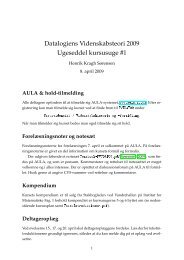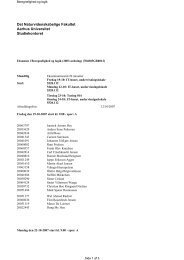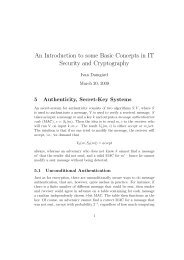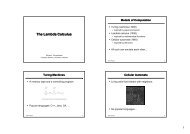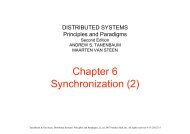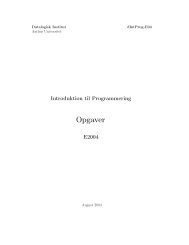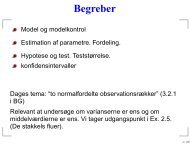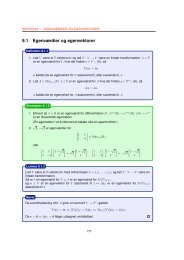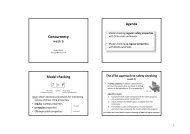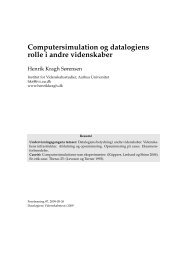Todays programme: Predicate Logic and Program Verification ...
Todays programme: Predicate Logic and Program Verification ...
Todays programme: Predicate Logic and Program Verification ...
Create successful ePaper yourself
Turn your PDF publications into a flip-book with our unique Google optimized e-Paper software.
<strong>Todays</strong> <strong>programme</strong>:<strong>Predicate</strong> <strong>Logic</strong> <strong>and</strong> <strong>Program</strong> <strong>Verification</strong>• Familiarity with basic concepts/results of predicate logic– Syntax: variables, quantification, scope– Semantics: interpretations, valuations, satisfaction truth, validity– Axiomatic proof system FOPL– Gödels completeness theorem for predicate logic• Describe the use of predicate logic in program verification– Syntax: program specifications, Hoare triples– Semantics: partial <strong>and</strong> total correctness– Proof system: Hoare proof rules<strong>Predicate</strong> <strong>Logic</strong>• Sten kan ikke flyve og morlille kan ikke flyveergo er morlille en sten!• (∀x. (S(x) → ¬ F(x))) ∧ ¬F(morlille)) |= S(morlille)•Fugle kan flyve og piphans er en fuglergo kan piphans flyve!•(∀x. (B(x) → F(x))) ∧ B(piphans)) |= F(piphans)dBerLog 20071dBerLog 20072<strong>Predicate</strong> <strong>Logic</strong><strong>Predicate</strong> <strong>Logic</strong>Female(girl).Floats(duck).Sameweigth(girl, duck).Witch(X) :- Burns(X).Burns(X) :- Wooden(X).Wooden(X) :- Floats(X).Floats(X) :- Sameweight(X, Y), Floats(Y).Witch(girl)?Female(girl),Floats(duck),Sameweigth(girl, duck),∀x Witch(x) ← Burns(x),∀x Burns(x) ← Wooden(x),∀x Wooden(x) ← Floats(x),∀ x,y (Floats(x) ← Sameweight(x, y) ∧ Floats(y))|= ?Witch(girl)dBerLog 20073dBerLog 20074
<strong>Predicate</strong> <strong>Logic</strong> - syntax examples• Constants:girl, duck• <strong>Predicate</strong> symbols P: Female, Floats,.... with arity 1Sameweight with arity 2<strong>Predicate</strong> <strong>Logic</strong> for Natural Numbers∀ ∀x. Even(x) → Even(succ(succ(x)))∀ ∀x. ∀y. (Even(x) ∧ y = x+2) → Even(y)∀ ∀x. x + 0 = x• (A(0) ∧ (∀x. A(x) → A(x+1)) → ∀x. A(x)dBerLog 20075dBerLog 20076<strong>Predicate</strong> <strong>Logic</strong> - syntax examples<strong>Predicate</strong> <strong>Logic</strong> - syntax• Constants:girl, duck• <strong>Predicate</strong> symbols P: Female, Floats,.... with arity 1Sameweight with arity 2• Variables x,y,z,...• Constants C: c 1, c 2,....• Function symbols F: f,g,h... each with some arity n>0• Constants 0,1,2,...• Function symbols F: +, × both with arity 2• <strong>Predicate</strong> symbols P: = with arity 2• Termst ::= c | x | f(t 1, t 2,..t n)dBerLog 20077dBerLog 20078
<strong>Predicate</strong> <strong>Logic</strong> - first order language, wwf’s• <strong>Predicate</strong> symbols P: P, Q, R each with some arity n≥0• Well formed formulae wff:Φ ::= P(t 1, t 2, .., t n) |¬ Φ | Φ ∨ Φ | Φ ∧ Φ | Φ → Φ |∀ x Φ | ∃ x Φ<strong>Predicate</strong> <strong>Logic</strong> - Interpretations• An interpretation I for a first order predicate logic languageconsists ofD, a domain of concrete valuesfor each constant c I an element of Dfor each f ∈ F with arity n, a function f I : D n → Dfor each P ∈ P with arity n, a subset P I ⊆ D ndBerLog 20079dBerLog 200710<strong>Predicate</strong> <strong>Logic</strong> - interpretations example<strong>Predicate</strong> <strong>Logic</strong>• D: objects from the real worldgirl: the girl in questionduck: the duck on the scalesFemale: those objects which are femaleSameweight: those pairs of objects with the sameweightI |= ¬Wooden(girl) ∧ ¬Witch(duck)I |= ∃ x Female(x) since I |= Female(girl)Female(girl),Floats(duck),Sameweigth(girl, duck),∀x Witch(x) ← Burns(x),∀x Burns(x) ← Wooden(x),∀x Wooden(x) ← Floats(x),∀ x,y (Floats(x) ← Sameweight(x, y) ∧ Floats(y))|= ?Witch(girl)dBerLog 200711dBerLog 200712
<strong>Predicate</strong> <strong>Logic</strong> - interpretations example• D: Natural numbers, N0,1,..: the numbers zero, one,...+, × : sum <strong>and</strong> mutiplication on N=: equality on NI |= ∀x. x + 0 = xI |=∀ x ∃ y (y = x+1)<strong>Predicate</strong> <strong>Logic</strong> - valuations• A valuation v in an interpretation I of a first order languageis a function from the terms of L to the domain D of I suchthatv(c) = c I for all constantsv(x) ∈ D for all variables xfor each f ∈ F with arity n, v(f(t 1,..,t n)) = f I (v(t 1),..,v(t n))• That is essentially a ”look-up table”v: free variables → DI |= x + 1 = y?dBerLog 200713dBerLog 200714<strong>Predicate</strong> logic - free <strong>and</strong> bound variables<strong>Predicate</strong> logic - free <strong>and</strong> bound variables• (∀x (P(x) ∧ Q(x)) → (P(x) → Q(y))• (∀x (P(x) ∧ Q(x)) → (P(x) → Q(y))→→∀ x→Scope of∀ x→∧PQ∧PQboundPQxyfreePQxyxxxxdBerLog 200715dBerLog 200716
<strong>Predicate</strong> <strong>Logic</strong> - satisfaction (semantics)• Given an interpretation, I, for a first order language, avaluation v, <strong>and</strong> a formula A, v satisfies A• I |= vAiff<strong>Predicate</strong> <strong>Logic</strong> - interpretations examplesD: natural numbers 0, 1, 2,...+, ×: adition <strong>and</strong> multiplication=: equalityif A = P(t 1, t 2,.., t n) then (v(t 1), v(t 2),.., v(t n)) ∈ P Iif A = ∀ x B then I |= v[x←d]B for all d ∈ DI |= v∃ y (y = x+1) ?if A = ∃ x B then I |= v[x←d]B for some d ∈ Dif A = ¬ B, B ∨ C, B ∧ C, B → Cthen ”as in propositional logic”dBerLog 200717dBerLog 200718<strong>Predicate</strong> <strong>Logic</strong> - interpretations examplesD: natural numbers 0, 1, 2,...+, ×: adition <strong>and</strong> multiplication=: equality<strong>Predicate</strong> <strong>Logic</strong> - interpretations examples• D: integers ...-2, -1, 0, 1, 2,...+, ×: adition <strong>and</strong> multiplication=: equalityI |= [0/x]∃ y (y = x+1)I |= [0/x]∃ y (x = y+1)I |= [0/x]∃ y (y = x+1)I |= [0/x]∃ y (x = y+1)dBerLog 200719dBerLog 200720
<strong>Predicate</strong> <strong>Logic</strong> -Truth <strong>and</strong> Validity• A wwf A is true in an interpretation I iff every valuation inI satisfies A, notation: I |= A• A wwf A is false in an interpretation I iff no valuation in Isatisfies A• A wwf A of a first order language L is (logically) valid iffit is true in every interpretation of L, notation: |= A• A wwf A of a first order language L is (logically)contradictory iff it is false in every interpretation of L<strong>Predicate</strong> <strong>Logic</strong> - interpretations examplesD: natural numbers 0, 1, 2,...+, ×: adition <strong>and</strong> multiplication=: equalityI |= ∀x ∃ y (y = x+1)I |= ∀x ∃ y (x = y+1) since I |= [0/x]∃ y (x = y+1)|= ∀x ∃ y (x = y+1) - follows from above!|= ∀x ∃ y (y = x+1) - why?dBerLog 200721dBerLog 200722<strong>Predicate</strong> <strong>Logic</strong> - quiz<strong>Predicate</strong> <strong>Logic</strong> - quizTruth in N:1. x+1 = y2. ∀x (x = x+1)3. ∀x ∀y (x+y = y+x)4. ∃ x (P(x) ∧¬ P(x))5. (∃ x ¬ P(x)) →(¬ ∀x P(x))True False Valid Contr.Truth in N:1. x+1 = y2. ∀x (x = x+1) √3. ∀x ∀y (x+y = y+x) √True False Valid Contr.4. ∃ x (P(x) ∧¬ P(x)) √ √5. (∃ x ¬ P(x)) →(¬ ∀x P(x)) √ √dBerLog 200723dBerLog 200724
<strong>Predicate</strong> <strong>Logic</strong> -Truth <strong>and</strong> Validity• Following Kelly we include the following predicateconstants in our syntax for predicate logic:• _|_ st<strong>and</strong>ing for the always false predicate, i.e. thepredicate which is false in every interpretation∀ ⎺ ⎺| st<strong>and</strong>ing for the always true predicate, i.e. thepredicate which is true in every interpretation<strong>Todays</strong> <strong>programme</strong>:<strong>Predicate</strong> <strong>Logic</strong> <strong>and</strong> <strong>Program</strong> <strong>Verification</strong>• Familiarity with basic concepts/results of predicate logic– Syntax: variables, quantification, scope– Semantics: interpretations, valuations, satisfaction truth, validity– Axiomatic proof system FOPL– Gödels completeness theorem for predicate logic• Describe the use of predicate logic in program verification– Syntax: program specifications, Hoare triples– Semantics: partial <strong>and</strong> total correctness– Proof system: Hoare proof rulesdBerLog 200725dBerLog 200726<strong>Predicate</strong> logic - axiomatic proof system<strong>Predicate</strong> logic - axiomatic proof system• Axioms:– Ax1 A → ( B → A)– Ax2 (A → ( B → C)) → ((A → B) → (A → C))– Ax3 (¬A → ¬ B) → (B → A)• Deduction rules: A, A → B– Modus ponens MP B• Axioms:– Ax1 A → ( B → A)– Ax2 (A → ( B → C)) → ((A → B) → (A → C))– Ax3 (¬A → ¬ B) → (B → A)– Ax4 (∀x) A(x) → A(t/x) where t is free for x in A!– Ax5 (∀x) (A → B) → (A → (∀x) B) no free occ’s of x in A!• Deduction rules: A, A → B– Modus ponens MP BdBerLog 200727dBerLog 200728
<strong>Predicate</strong> logic - substitutionA[t/x] notation for”A with all free occurrences of x substituted by t”• Examples((∀x (P(x) ∧ Q(x)) → (P(x) → Q(y))) [f(y)/x] =(∀x (P(x) ∧ Q(x)) → (P(f(y)) → Q(y))((∀y (P(y) ∧ Q(x)) → (P(y) → Q(x))) [f(y)/x] = ??<strong>Predicate</strong> logic - substitution• A[t/x] is only defined if ”t is free for x in A”:no free occurrence of x in A occurs within the scope of∀y or ∃y for any variable y occurring in t• For all t,x,A, - t can always be made free for x in Aby a suitable renaming of bindings ∀y, ∃y in A• Example((∀y (P(y) ∧ Q(x)) → (P(y) → Q(x))) [f(y)/x] =(∀z (P(z) ∧ Q(f(y))) → (P(y) → Q(f(y)))dBerLog 200729dBerLog 200730<strong>Predicate</strong> logic - axiomatic proof systemExample of proof• Axioms:– Ax1 A → ( B → A)– Ax2 (A → ( B → C)) → ((A → B) → (A → C))– Ax3 (¬A → ¬ B) → (B → A)– Ax4 (∀x) A(x) → A(t) where t is free for x in A!– Ax5 (∀x) (A → B) → (A → (∀x) B) no free occ’s of x in A!• Inference rules: A, A → B– Modus ponens MP B• Assume that y does not occur in A(x)Prove (∀x) A(x) → (∀y) A(y)1. (∀x) A(x) Hyp2. (∀x) A(x) → A(y) Ax4 (y free for x in A)3. A(y) MP 1,24. (∀y) A(y) G– Generalisation G A(∀x) AdBerLog 200731dBerLog 200732
Pred. <strong>Logic</strong> - soundness <strong>and</strong> completeness• Gödel’s Completeness TheoremOur set of proof rules (the 3 axioms <strong>and</strong> MP frompropositional logic plus the 2 extra axioms <strong>and</strong> G) issound <strong>and</strong> complete for predicate logic!• ProofLook for Gödel’s proof!dBerLog 200733Validity for predicate logic• Validity problem for predicate logic:Given a first order predicate logic formula A,is A valid, i.e. |= A?• TheoremThe validity problem for predicate logic is unsolvableProof: can be shown by a reduction from PCP•CorollaryThe set of valid formulas in predicate logic isrecursively enumerable, but not recursiveProof: ??dBerLog 200734Validity for predicate logic• Validity problem for predicate logic:Given a first order predicate logic formula A,is A valid, i.e. |= A?• TheoremThe validity problem for predicate logic is unsolvableProof: can be shown by a reduction from PCP•CorollaryThe set of valid formulas in predicate logic isrecursively enumerable, but not recursiveProof: Gödel’s completeness theoremdBerLog 200735<strong>Todays</strong> <strong>programme</strong>:<strong>Predicate</strong> <strong>Logic</strong> <strong>and</strong> <strong>Program</strong> <strong>Verification</strong>• Familiarity with basic concepts/results of predicate logic– Syntax: variables, quantification, scope– Semantics: interpretations, valuations, satisfaction truth, validity– Axiomatic proof system FOPL– Gödels completeness theorem for predicate logic• Describe the use of predicate logic in program verification– Syntax: program specifications, Hoare triples– Semantics: partial <strong>and</strong> total correctness– Proof system: Hoare proof rulesdBerLog 200736
<strong>Program</strong>ming language PLN - syntax• Constants:natural numbers: 0, 1, 2,..boolean constants: true, false• Con ::= 0, 1, 2, ...• Var::= x, y, z, ...• E::= Con | Var | E + E | E ∗ E | (E)• B::= true | false | ¬B | B ∧ B | B∨ B | E = E | (B)• C::= x := E | C ; C | if B then C else C | while B do CPLN example C = Facy := 1; z := 0;while ¬ (z = x) doz := z + 1y := y ∗ zdBerLog 200737dBerLog 200738PLN semanticsPLN semantics, example C = Fac• A PLN state associates natural numbers to programvariables: States: Var → N• The operational semantics of PLN defines the semantics ofa program C as a PARTIAL functionSem[C]: States → Stateswhere Sem[C](s) =s’ if C when started in state sterminates in state s’undefinedotherwisey := 1; z := 0;while ¬ (z = x) doz := z + 1y := y ∗ zSem[Fac](x = 4, y = 0, z = 0,...) =(x= 4, y = 24, z = 4,...)dBerLog 200739dBerLog 200740
PLN specifications syntax• A correctnes specification of a program C is a Hoare tripleof the form{ φ } C { ψ }where φ (precondition) <strong>and</strong> ψ (postcondition) are first orderpredicate logic formulae over variables (including PLNprogram variables) <strong>and</strong> constants/functions/predicatesinterpreted in the model of natural numbers.Hoare triples - for Facy := 1; z := 0;while ¬ (z = x) doz := z + 1y := y ∗ z• |= par {⎺ ⎺| } Fac {y = x!}• |= par{x>5} Fac {z=x}• |= tot {⎺ ⎺| } Fac {y = x!}dBerLog 200741dBerLog 200742Pre/postcondition interpretationHoare triples - semantics• Let N be the predicate logic interpretation of naturalnumbers with a (yet unspecified) vocabulary of constants,functions <strong>and</strong> predicates - all interpreted ”in the st<strong>and</strong>ardway”.• Note that PLN states are nothing but predicate logicvaluations!• { φ } C { ψ } is said to be satisfied under partial correctness|= par{ φ } C { ψ }iff for all states s,if N |= sφ, <strong>and</strong> Sem[C](s) is defined <strong>and</strong> equal to s’then N |= s’ψ• { φ } C { ψ } is said to be satisfied under total correctness|= tot{ φ } C { ψ }iff for all states s,if N |= sφ, thenSem[C](s) is defined, <strong>and</strong> if Sem[C](s) = s’ then N |= s’ψdBerLog 200743dBerLog 200744
Hoare proof rules := <strong>and</strong> ;Hoare proof rules if <strong>and</strong> while{ψ [E/x]} x := E {ψ}Ass-axiom{φ ∧ B} C {ψ} {φ ∧ ¬B} 1C {ψ} 2If-rule{φ} if B then C 1else C 2{ψ}{φ} C 1 {η} {η} C 2{ψ}Comp-rule{ψ ∧ B} C {ψ}While-rule{φ} C 1; C 2 {ψ}{ψ} while B do C {ψ ∧ ¬B}dBerLog 200745dBerLog 200746A proof of Euclid’s gcd algorithmA proof of Euclid’s gcd algorithm{ m = m 0≥ 1 ∧ n = n 0≥ 1 }{ m = m 0≥ 1 ∧ n = n 0≥ 1 }while ¬ (m = n) dowhile ¬ (m = n) doif m > n then m:=m-nif m > n then m:=m-nelse n:= n-m;else n:= n-m;{η}r:= m{ r = gcd(m 0, n 0) }r:= m{ r = gcd(m 0, n 0) }dBerLog 200747dBerLog 200748
A proof of Euclid’s gcd algorithmA proof of Euclid’s gcd algorithm{ m = m 0≥ 1 ∧ n = n 0≥ 1 }while ¬ (m = n) doif m > n then m:=m-n{m = gcd(m 0, n 0) }r:= m{ r = gcd(m 0, n 0) }else n:= n-m;Ass-axiom{m = gcd(m 0, n 0)} r := m {r = gcd(m 0, n 0) }{ m = m 0≥ 1 ∧ n = n 0≥ 1 }while ¬ (m = n) do{ gcd(m,n) = gcd(m 0, n 0) }if m > n then m:=m-n{m = gcd(m 0, n 0) }r:= m{ r = gcd(m 0, n 0) }else n:= n-m;dBerLog 200749dBerLog 200750A proof of Euclid’s gcd algorithmHoare proof rules - implied{ m = m 0≥ 1 ∧ n = n 0≥ 1 }while ¬ (m = n) do{ gcd(m,n) = gcd(m 0, n 0) }if m > n then m:=m-n{m = gcd(m 0, n 0) }r:= m{ r = gcd(m 0, n 0) }dBerLog 2007else n:= n-m;{gcd(m,n) = gcd(m 0, n 0) ∧ ¬ (m = n) }if m > n then m:=m-nelse n:= n-m;{gcd(m,n) = gcd(m 0, n 0) }{gcd(m,n) = gcd(m 0, n 0) }while ...{gcd(m,n) = gcd(m 0, n 0) ∧ ¬ ¬(m = n) }While-rule51dBerLog 2007|- Nφ’ → φ {φ} C {ψ} |- Nψ→ ψ’{φ’} C {ψ’}Impl-ruleNOTE We assume here that we have some underlyingextension of the proof system for predicate logic, in which we proveformulae of the form φ’ → φ which are true in N - the interpretation ofnatural numbers!!!!52
A proof of Euclid’s gcd algorithmProofs using Hoare rules{ m = m 0≥ 1 ∧ n = n 0≥ 1 }while ¬ (m = n) do{ gcd(m,n) = gcd(m 0, n 0) }if m > n then m:=m-n{m = gcd(m 0, n 0) }r:= m{ r = gcd(m 0, n 0) }else n:= n-m;Proof obligations Comp rule:|- Nm = m 0≥ 1 ∧ n = n 0≥ 1-> gcd(m,n) = gcd(m 0,n 0)|- Ngcd(m,n)= gcd(m 0,n 0) ∧¬¬(m=n)-> m = gcd(m 0, n 0)• Notation:|- par{ φ } C { ψ } iff{ φ } C { ψ } has a proof using the Hoare rules<strong>and</strong> rules for |- N!!• Are the Hoare rules sound <strong>and</strong> complete, i.e|- par{ φ } C { ψ } iff |= par{ φ } C { ψ } ???dBerLog 200753dBerLog 200754<strong>Todays</strong> <strong>programme</strong>:<strong>Predicate</strong> <strong>Logic</strong> <strong>and</strong> <strong>Program</strong> <strong>Verification</strong>• Familiarity with basic concepts/results of predicate logic– Syntax: variables, quantification, scope– Semantics: interpretations, valuations, satisfaction truth, validity– Axiomatic proof system FOPL– Gödels completeness theorem for predicate logic• Describe the use of predicate logic in program verification– Syntax: program specifications, Hoare triples– Semantics: partial <strong>and</strong> total correctness– Proof system: Hoare proof rulesExercises• Describe the semantics of predicate logic– Kelly page 123 6.7 (scope rules)– Kelly page 130 6.9 (expressiveness– Kelly page 136 6.12 (satisfaction)– Kelly page 138 6.19 (satisfiability, truth, validity)• Describe <strong>and</strong> construct deductions in FOPL– Kelly page 160 7.1 (i) (ii)• Describe <strong>and</strong> construct deductions for Hoare triples– LimProVer page 10 Exercise 1dBerLog 200755dBerLog 200756



